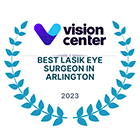
Vision correction may assist people with either myopia or astigmatism. For some people, LASIK surgery is an option that allows them to see clearly and ditch their contacts or glasses. However, it helps to know how the underlying cause -- myopia or astigmatism -- differs.
General Information About Myopia
Myopia, also known as nearsightedness, is when you can't see well far away but can see up close clearly. With myopia, the shape of your eye, or parts of it, causes the light to bend improperly and shine before your retina instead of on it. This causes difficulty when you look at objects at a distance.
Why It Happens
Myopia may arise when you have an issue with the size of your cornea or a condition that affects it. In some cases, it's the shape of your eye, which is longer than normal.
In many cases, this is a genetic condition, meaning you're more at risk for having it if a parent has it. However, performing up-close tasks frequently can increase a person's risk. During childhood, a kid is more likely to develop myopia if he or she uses smart devices or computers for prolonged periods.
As noted by the Mayo Clinic, studies have shown people who spend less time outdoors may have a greater likelihood of myopia than someone who is outside frequently.
When It Occurs
Most people develop myopia during childhood or adolescence. Between the ages of 20 and 40, your sight will usually become stable and not change anymore.
How It's Diagnosed
An optometrist or ophthalmologist may diagnose myopia using a standardized vision screening. This is the test when an eye doctor places a large device (phoropter) up to your face and asks you to read lines of letters.
General Information About Astigmatism
Astigmatism causes blurry vision at all distances. Like with myopia, it's a refractive error, meaning light doesn't shine on the retina properly. Only with astigmatism, the light enters the light and scatters rather than it focusing on the retina. Thus, the person has difficulty seeing up close and far away. Astigmatism can co-occur with myopia and also hyperopia (farsightedness).
Why It Happens
Sometimes, when you have astigmatism, your eye isn't shaped like a ball, which the average eye is. Instead, your eye has a shape more similar to a football, which distorts the light when it enters your eye.
On the other hand, you may have lenticular astigmatism, which occurs when you have a lens with curvature more toward one direction than the other.
Some people may develop astigmatism after eye surgery or injury. However, in people who have had it since birth, it's thought to be genetic, though doctors aren't sure exactly what causes it. And there's no way to prevent it.
When It Happens
Many times, astigmatism is present at birth. It, however, may not be severe enough to require treatment. In some cases, it'll worsen over time. However, most often, it remains stable until a person turns 50. At that point, it may worsen because of pressure being placed on the cornea from your eyelids.
How It's Diagnosed
Whenever you have a vision screening from an ophthalmologist, you complete an astigmatism test. During this portion of the exam, you look at a series of two images and decide which one looks more clear.
Treating Astigmatism and Myopia
In mild to moderate cases of astigmatism or myopia, glasses or contact lenses may correct your vision. The more serious cases of astigmatism may require specialized contacts, known as toric lenses, to correct the problem optimally.
LASIK eye surgery is another option for either. And LASIK surgery may either reduce or eliminate your need for corrective eyewear, depending on the severity of your condition and eye health.
If you're interested in LASIK eye surgery or would like an eye exam for myopia and astigmatism, contact Silk Vision & Surgical Center at 703-876-9700 or by using our online scheduling tool.











.png)
